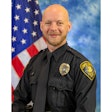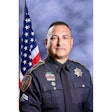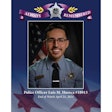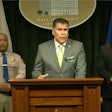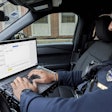Sometimes, somebody else starts the job. Sometimes, you finish it—that is, unless the job finishes you.
Such was the case on Dec. 4, 2001. At 7:45 that evening, Overland, Kan., police Sgt. Bob Kolenda received a page from Det. Sgt. Barb Walk: His team was to provide relief on a surveillance detail.
The Overland Police Department operation was part of an ongoing fraud and forgery investigation initiated earlier in the day with the service of a search warrant at the Cedar Crest apartment complex. At the time, resident and investigatory target Marcus R. Brown was away at work. Intel had it that Brown was scheduled to get off work around 9:30 that night. The police would be ready.
Operating under the assumption that Brown remained ignorant that he was on the Overland PD's radar, Kolenda began to coordinate his resources and personnel. Initial relief of those Criminal Intelligence Division detectives on the scene—Jose Carrillo and Ron Frazier—would be made by himself and Det. Jesse Rollwagen. As Rollwagen had been working all day and was a case study in sleep deprivation, he was to be relieved as soon as possible by Det. Terry Schmidt.
Not that Kolenda was feeling particularly fresh himself; he'd been up since 5:30 that morning.
But no overwhelming fatigue accompanied Kolenda as he parked just outside of the apartment in the 6000 block of West 91 Street at 8:30 that night. Over the course of the next hour, things went as planned. Reliefs were made, more intel was passed on, and pictures of their quarry reviewed.
All that was left was for Brown to show up in his tan colored Ford Explorer.
The Waiting Game
Kolenda and Schmidt sat in a pickup just south of the location when a fellow detective gave them a heads up over the cellular: Not only would Brown most likely resist arrest, he was strong enough to make it a good fight.
The detective added another tidbit. Brown had an associate out of Washington: David Peterson. A black male in his 30s, Peterson had a confirmed homicide warrant out of Seattle. Considered armed and dangerous, he was last known to be headed out of town on I-70 in a teal Lincoln Continental.
While it would prove to be invaluable officer safety information, at the time Kolenda did not believe that Peterson could complicate the operation because he was seen leaving the area. Therefore he did not feel that he needed to impose upon SWAT to assist in the surveillance.
Schmidt and Kolenda considered their strategic options, opting to allow Brown to enter the apartment complex. Since the door lock to Brown's apartment was changed at the time the search warrant was served, Brown would be unable to enter the locked room. The situation would effectively maroon him on the second floor landing, a controlled environment that would effectively limit his ability to resist arrest or escape.
With tactical notifications made and a game plan in place, there was little else to do but wait.
Target in sight
Another hour passed. At approximately 2230 hours, a tan Ford Explorer occupied by two black males pulled into the parking lot and parked just northwest of their location.
Schmidt immediately notified the Tactical Operations Center and requested two marked units for backup. While the driver appeared to be the suspect Marcus Brown, the visage of his male passenger was hidden by the dark hooded sweatshirt that he was wearing. All the same, both detectives couldn't help but notice that the man bore an uncomfortably close resemblance to the potentially armed-and-dangerous Peterson who was wanted on a homicide rap.
The two detectives hurriedly exited Schmidt's truck and made a stealthy approach to the apartment complex. If spotted by the suspects, there would be little mistaking the significance of the soft body armor, carriers emblazoned with large gold police badges on the chest, and the word POLICE on the back in white letters. As they approached, Kolenda directed Schmidt to call in the license on the Explorer.
Nearing the apartment building, Kolenda could see both men on the upper landing trying to gain access to the apartment. While Brown remained at the door, the other suspect suddenly began a rapid descent of the steps. Kolenda cursed his luck, sure that the second male might have seen him as he came down the steps.
Seeing the man making his way toward the front door of the apartment building where he stood, Kolenda prepared to challenge him with his pistol at low ready.
But at the door, something went terribly wrong. To this day, Kolenda isn't sure how the door came open, only that it did.
I've Been Shot!
As the door swung open, Kolenda saw the man's hands extend in his direction. For Kolenda, it would be the last telltale sign that something was going terribly wrong.
Before he could finish the first syllable of "Police!" there was a loud bang. Kolenda felt something smash into his lower right jaw; a hollow-point round had impacted with such force that it dislodged three of Kolenda's teeth, embedding them in other parts of his mouth before the bullet continued down the back of his throat and came to rest in his left lung.
Any questions about the man's identity quickly dissipated, and the officer knew that even if Peterson wasn't already wanted for murder, the man had committed himself to a tragic course of action. Kolenda wasn't about to let himself end up on the wrong end of that equation and responded immediately.
Bringing his own gun up, his eyes picked up his front sights of his .40 cal. Glock model 22. He focused on center mass, the figure before him at once blurring and becoming the familiar target silhouette he'd engaged so many times on the firing line. Only this time, it was real, alive, and determined to kill him.
Kolenda squeezed off three quick rounds—a "triple tap." But his assailant was still on his feet and, therefore, still a threat. Kolenda fired a second three-round volley. With the sixth round, the suspect collapsed to the ground, and the door between them slid shut, cutting off Kolenda's view of the suspect.
Taking a protective step back, Kolenda glanced through the side light window. As he did, he saw Marcus Brown rushing down the steps. Aside from cops, Kolenda didn't know too many people who ran toward the sound of gunfire unless they were inclined to join the fray. Perceiving Brown's aggressive approach as a threat, Kolenda fired one round through the side light window at the man. Brown immediately dropped to the steps.
Kolenda went to one knee, continuing to cover the door and watch Brown. With what voice he had left, he told Schmidt that he'd been hit. With remarkable courage, Schmidt immediately moved to the door to engage the suspects. Opening it, he found Peterson collapsed on the floor in the hallway; Brown was curled up in a fetal position midway down the stairwell. Kolenda could hear Schmidt give verbal commands to both downed suspects, announcing that they were the police and directing them not to move. Kolenda held his position until backup arrived.
Intensive Care
The first two officers to Kolenda's aid were Warren Neff and Brian Hampton. They walked him to the parking lot and sat Kolenda on the bumper of a patrol car to await the ambulance as blood pooled to the asphalt below him. He released his firearm and police equipment to Hampton.
For his efforts, Peterson succeeded in getting himself shot three times by Kolenda. The first Speer Gold Dot round went through Peterson's right wrist, left wrist, and into a wall; the second struck him in the left shoulder and traversed down into the abdominal cavity; the third struck the suspect in his right rear buttocks before ending up six inches from where the second round had come to rest.
Sure that he was dying—and who could blame him?—Peterson asked officers to tell his momma he loved her.
But it was not to be. Surgeons saved Peterson's life, thereby ensuring the rest of it would be spent in state prison.
Not that Kolenda didn't endure his own personal hell while recovering from the assault. The morning following the shooting, surgeons removed the round. That operation required him to endure a tracheotomy.
Reflections
Looking back, Kolenda is thankful that the detective had called to share the information about Peterson. While it did not prevent his getting shot, it helped establish for him a conditioned mindset when entering the confrontation with Peterson.
Kolenda believes that three core beliefs and practices helped him survive the incident, and he imparts them to those he continues to train today as a captain.
"Take your training seriously," he says. "I responded as I was trained, which kept him from getting off a second shot."
As part of his own training, Kolenda had envisioned possible shooting situations and played out scenarios in his mind for years prior to the shooting. But one consideration had evaded him until it happened—having to engage a suspect once he'd already been shot. While not a pleasant consideration, he recommends it as a means of adding one more tool to one's arsenal.
Kolenda noticed that his first round struck Peterson's hands, the threat epicenter. In this regard, his target acquisition turned out to be what the range instructor within him would have expected from someone consciously or not directing their rounds where they were most needed to get themselves out of harm's way as quickly as possible.
The second thing Kolenda recommends is being physically fit. Each week, Kolenda cross trains, putting in 19 to 24 running miles and lifting weights. He stresses that it not only helps with the physical rigors of the job, but helps alleviate stress.
Finally, Kolenda credits his having a strong relationship with God for helping him prevail in his gun battle with Peterson and with helping him survive being shot during the incident.
"I know God was right there with me through all this," Kolenda reflects. "Terry and I had switched positions just prior to reaching the door. Even though I had sustained a serious injury, God gave me the strength to respond. I did not lose consciousness and had a clear mind, and I did not feel any pain until some two and a half hours later."
Kolenda's faith also comforted him after the shooting while his fellow officers were rendering aid. "When the shooting stopped I had an unreal peace about me. This is a peace only God can provide. It is the peace that surpasses all understanding," he says referencing the Bible verse Philippians 4:7. "I knew I was going to be OK. I also knew without a doubt that if I should die I would see Jesus. I had believed this as a matter of faith and because of God's promise in the Bible. But that night it became more than just faith. It became very real to me."
Kolenda says that he steadfastly believes the hands of providence were upon him that night more than six year ago, and he offers as evidence the circumstances that led him to be shot while working with men who knew how to respond to his wounds.
"Other things strengthen my conviction on this point. Overland Park Police Department has 214 officers, but only two of them—Brian Hampton and Mike Satter—are trained paramedics. Yet they just happened to be among the first officers to assist me. Some might call this a coincidence—I call it a miracle. I can't tell you how much comfort it gave me having them attend to me."
WHAT WOULD YOU DO?
Put yourself in the shoes of Sgt. Bob Kolenda of the Overland (Kan.) Police Department and consider these questions.
-
Kolenda did not request SWAT to assist in the operation as the information regarding the wanted murder suspect indicated that he had left the area. At what point do you decide to call in outside resources? How strict are your agency's SWAT deployment criteria?
-
Kolenda was able to articulate his reason for shooting at the second suspect who was descending the stairwell. Nonetheless, he was thankful that the suspect—who was not shooting at him—wasn't hit. Would you have taken the shot? What would you have done?
- One of the primary factors that Kolenda feels helped him to survive the shooting was a strong and abiding faith in God. How do your personal beliefs and/or religious faith help you perform your job?









